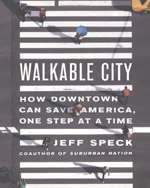
I don’t read many mass market city planning books anymore, because so many of them say the same things. But when I heard one of the authors of Suburban Nation had his own book, I had to give it a shot. Suburban Nation is still the most eminently readable and easy to understand discussion of 20th Century suburbs, and why urban neighborhoods are better.
In some ways, Walkable City is like all those other books. It says mixed use and transit are good, wide highways and blank walls are bad. Most of us in the city planning world already know these things.
But Walkable City is worth reading, because Speck gathers a mountain of data supporting most of the arguments in contemporary urbanism, and then presents it in a convincing, methodological, and easy to read way. If you already know the basics, Walkable City is the most complete reference available.
And it does have new arguments. For example, Speck’s discussion of walkable architecture is intriguing, and explains in detail why it isn’t the ornament of historic buildings that makes them superior to most contemporary ones, but that they have layers of interesting things to look at, from different scales, and that walkers can interact with them in ways other than staring at a wall (even a decorated one).
Maybe I just like the book because I’m in it. Much to my surprise. I was reading it one day on the Metro and then, unexpectedly, on page 58, saw my own name, quoted regarded LEED architecture.
But perhaps the best thing I can say about Walkable City is this: After reading the first couple of chapters in a cafe, I went home, got a pen, and started over. Now my copy is covered with notes and squiggles from front to back.










Hi Dan,
Thanks for suggesting this book. I downloaded a copy to my kindle last night and got 10% of the way through it. The book is very readable, if you enjoy this blog then I think you’d like and be able to get into the book as well. I grew up in the burbs and moved to the city in 2005 and I’ll never look back, so you could say that I’ve drank the kool-aid already, but this book does a great job articulating all the reasons that I love walking (and biking) through the city and how Denver keeps getting better but with room for more improvement. I’m not sure if Speck touches on the point of street art, but when buildings lack architectural detail, I think the walk can be made great via street murals like what we have on Upper Larimer where most of the buildings are square cement warehouses.
Thanks again for the reading tip, I look forward to digging in to this book even further.
Downloaded this a few months back. Very enjoyable and informative!
I agree. This book is fantastic, and filled with tons of support for some of the counter-intuitive arguments such as induced demand.
I’m more than a third done with this book and it is incredible. It has truly changed the way that I think about our streets, transit, sidewalks and urbanism in general. It’s really motivated me to read the other books mentioned and to consider getting a MURP.